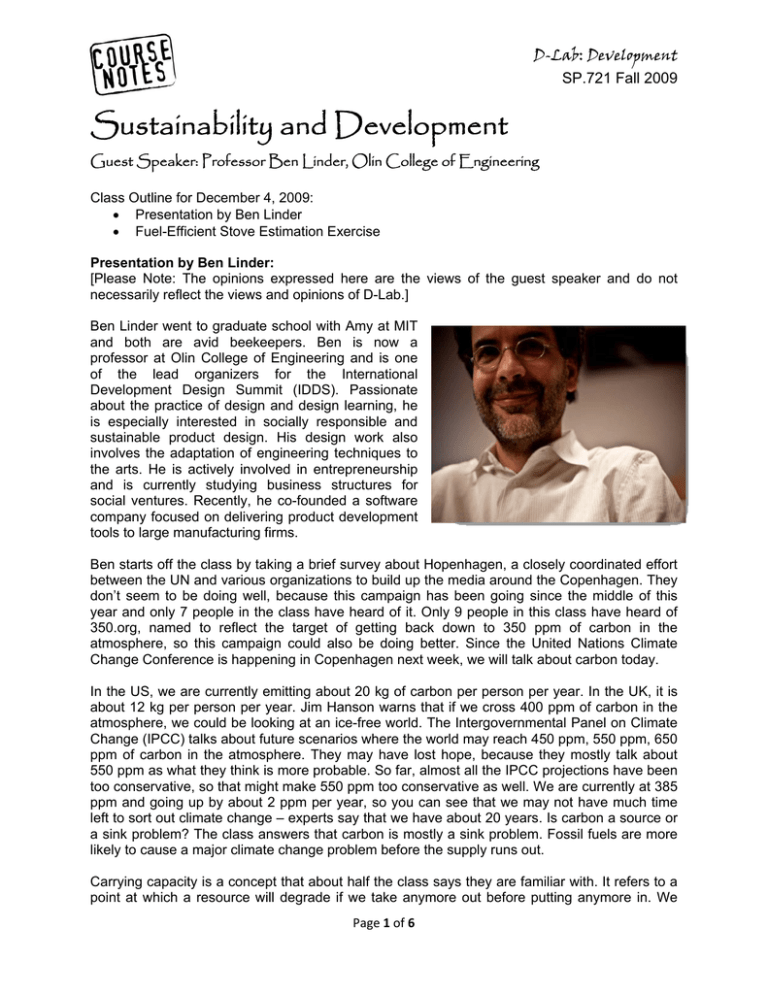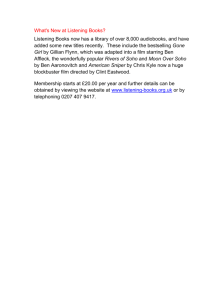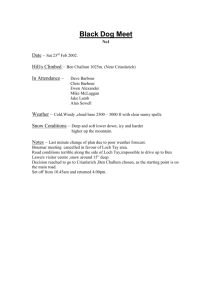
D-Lab: Development
SP.721 Fall 2009
Sustainability and Development
Guest Speaker: Professor Ben Linder, Olin College of Engineering
Class Outline for December 4, 2009:
• Presentation by Ben Linder
• Fuel-Efficient Stove Estimation Exercise
Presentation by Ben Linder:
[Please Note: The opinions expressed here are the views of the guest speaker and do not
necessarily reflect the views and opinions of D-Lab.]
Ben Linder went to graduate school with Amy at MIT
and both are avid beekeepers. Ben is now a
professor at Olin College of Engineering and is one
of the lead organizers for the International
Development Design Summit (IDDS). Passionate
about the practice of design and design learning, he
is especially interested in socially responsible and
sustainable product design. His design work also
involves the adaptation of engineering techniques to
the arts. He is actively involved in entrepreneurship
and is currently studying business structures for
social ventures. Recently, he co-founded a software
company focused on delivering product development
tools to large manufacturing firms.
Ben starts off the class by taking a brief survey about Hopenhagen, a closely coordinated effort
between the UN and various organizations to build up the media around the Copenhagen. They
don’t seem to be doing well, because this campaign has been going since the middle of this
year and only 7 people in the class have heard of it. Only 9 people in this class have heard of
350.org, named to reflect the target of getting back down to 350 ppm of carbon in the
atmosphere, so this campaign could also be doing better. Since the United Nations Climate
Change Conference is happening in Copenhagen next week, we will talk about carbon today.
In the US, we are currently emitting about 20 kg of carbon per person per year. In the UK, it is
about 12 kg per person per year. Jim Hanson warns that if we cross 400 ppm of carbon in the
atmosphere, we could be looking at an ice-free world. The Intergovernmental Panel on Climate
Change (IPCC) talks about future scenarios where the world may reach 450 ppm, 550 ppm, 650
ppm of carbon in the atmosphere. They may have lost hope, because they mostly talk about
550 ppm as what they think is more probable. So far, almost all the IPCC projections have been
too conservative, so that might make 550 ppm too conservative as well. We are currently at 385
ppm and going up by about 2 ppm per year, so you can see that we may not have much time
left to sort out climate change – experts say that we have about 20 years. Is carbon a source or
a sink problem? The class answers that carbon is mostly a sink problem. Fossil fuels are more
likely to cause a major climate change problem before the supply runs out.
Carrying capacity is a concept that about half the class says they are familiar with. It refers to a
point at which a resource will degrade if we take anymore out before putting anymore in. We
Page 1 of 6
should take no more wood from a forest than the rate at which it would cause the forest to lose
biomass, degrading the forest. If you never exceed this carrying capacity, then you can take
wood out forever. If you exceed it a little, you need to take less out or none out for a while to let
the natural system recover. Natural systems can be incredibly resilient. If you exceed the
carrying capacity by too much, however, the system can degrade. There can even be a positive
feedback loop that causes a runaway system.
If we had a better sense of what is the carrying capacity of the population of a fish, then we
could try to avoid a population collapse like what happened with the Atlantic Cod. What does it
mean to no longer have the Atlantic Cod in the world anymore? Experts have estimated 25%
species extinction by 2050.
There are 3 important rules to remember:
1. You have to measure carrying capacity. [Note: It can be really difficult to measure this
in a dynamic system. People pursue entire careers around this.]
2. You have to stay under carrying capacity.
3. You have to be well-adapted. [Note: There is a whole other career around how to build
adapted systems.]
We can also talk about natural capital. What kind of resources and natural services are we
getting from the environment? What is their value to us? For example, fresh water would have
to be replaced by desalination of salty water. How much would it cost to build a desalination
plant? Around the world, a big natural resource is fuel, in various forms (biomass, natural gas,
etc.). The estimated value of natural capital has been $16-54 million when the global value of
the market was $30 trillion. As designers and engineers, do we actually create wealth? We are
good at taking natural materials and translating them into usable form, but the actual root value
usually comes from the materials, rather than from what we make.
First coined by John Elkington, the Triple Bottom Line of economic, social and environmental
returns (also known as “People, Planet, Profit”) is often depicted as a venn diagramm, but it is
more accurately represented as embedded circles so you can see the boundary conditions. You
have to pass through society to go from monetary sustainability to environmental sustainability.
You can talk about designing closed loop systems, but the funny thing about the second law of
thermodynamics is that energy actually flows through systems.
Market
Society
Environment
Ben shows a graph of normalized Human Development Index (HDI) against a measure of
ecological footprint (E), reproduced on the next page. HDI measures basic health (including
mortality and morbidity), education (including literacy and rates of completion for primary and
secondary school), and economics (including income in purchasing power parity). E includes
things like water, land, food, and greenhouse gas emissions. When we talk about the definition
of sustainability, you almost invariably see definitions like the following:
"Sustainable development is development that meets the needs of the present
without compromising the ability of future generations to meet their own needs.”
~Brundtland Commission
Page 2 of 6
You can think of sustainability as having two major components: human development and
environmental. Our quality of life is inextricably linked to our environmental impact. If you look at
water, sanitation, and other conditions that impact health, which is a part of quality of life, you
can see that they all are linked to environmental resources.
NOTE: Error in the figure, Brazil should be labelled as country in Latin America, not Europe.
© Making It. All rights reserved. This content is excluded from our Creative
Commons license. For more information, see http://ocw.mit.edu/fairuse.
This graph is important because it shows that our quality of life that does not necessarily come
only at the cost of greater environmental impact. For example, Cuba (in the upper left-hand
corner of the yellow quadrant) has relatively high health care and education quality, but
relatively low environmental impact compared to many industrialized nations. Development and
sustainability are not linearly related. In fact, it is only with the most developed countries, like the
US, where a relatively high quality of life is correlated with a very high environmental impact.
How can we decouple development from environmental impact? We want to be able to address
human development issues such as health and education while not incurring a lot of negative
environmental impact. There are many different approaches. One of the first things we have to
do is define the region/context we are talking about so we can measure the carrying capacity. If
we look at ecological footprint and available biocapacity by region, we can see that the US and
Western Europe have exceed where they should be, and places like Asia and Africa are under
where they could be. Places like London need way more land than they actually occupy to
produce enough resources to sustain them, so they often extract them from elsewhere, such as
developing countries. The fact that we trade allows us to maximize the population we can put on
any given ecosystem. If there is a limiting resource, we can exchange with another ecosystem
to satisfy our demand. This is what has allowed us to increase our population substantially in
certain areas, over what may be sustainable.
Page 3 of 6
We are looking to both minimize the resources we use as well as use better resources such as
renewable energy. Some resources, like sand and salt water, may be abundant, however, we
want to use resources that are not only abundant and renewable, but high quality. It is not
enough to just have a more efficient stove to reduce fuel consumption; you also need to have a
management program for the fuel that feeds the stove. We might expect that in general, fuel
consumption would decrease as income increases, since people tend to shift toward using
resources that are more efficient and of higher quality. This is not always the case, however,
because it depends on what is available in the region we are talking about.
Public domain photo (NASA).
Ben shows a powerful picture where the Dominican Republic is covered in forest on one side of
the island, and Haiti has very little forest on the other side of the island. A lot of this difference is
due to policy. We cannot take this as the full picture of what is happening, but the collapse of
the forest in Haiti is very real, not to mention one of the reasons why we are working on
agricultural waste charcoal as an alternative fuel source. If you look at energy consumption by
source in Haiti, biomass dominates the “other” non-fossil-fuel-based sources outside of
hydroelectric and nuclear power. Haiti has even turned to the Dominican Republic to source
enough wood for making wood charcoal, which 70% of the population uses to cook. In Africa,
about 80% of the energy consumption among people living in poverty is from biomass, such as
wood or dung. Around the world, about 60% of people living in poverty use biomass for fuel.
SELCO Co-Founder Harish Hande, who leads a solar company in India, is famous for making
the argument about how valuable solar power can be in the development context. Solar power
can make sense for people living in poor rural communities, even though it may not be as cheap
as other energy sources. In the US, we tend to think about solar panels as something to protect
the environment. Solar makes less sense economically in the US because with all the subsidies
tied to conventional electricity sources, we do not see the real price of electricity. SELCO thinks
about solar in terms of its potential to impact development instead. SELCO would have to spend
their entire budget to find out what their environmental impact really is in India and they do not
want to make claims they cannot support, but they can measure increased productivity of their
customers and that is something that really matters to them.
Envirofit is another interesting company that works on motorbike retrofits in South East Asia.
The motorbikes commonly used for transport in developing countries can each put out as much
pollution as 50 cars. The Envirofit retrofit system reduces environmental impact while allowing
taxi drivers to earn more money by decreasing the amount of fuel used. Solutions do exist
where you can increase the developmental impact while reducing environmental impact.
Page 4 of 6
The interesting thing is if you ask where SELCO and Envirofit are going, they are both looking
into stoves. That target corner of the development-environmental impact space has major
opportunities.
Page 5 of 6
Fuel-Efficient Stove Estimation Exercise:
The students are split into groups for this activity. [Aside: Ben realized that many people are
sitting on the floor because we have switched classrooms today for group exercises and there
are not enough seats. Amy jokes that this is like the $2 day activity, except we’re practicing lack
of furniture. Ben adds that we shouldn’t use computers or pencils for this activity either. Amy
responds that we have abacuses for everyone.]
Each group receives two documents. One document gives the embodied energy & carbon for
different types of materials. Embodied energy is how much energy it takes to make something,
such as a kilogram of concrete or steel. Embodied carbon is how much carbon is emitted
through use of that material. The other document is a cheat sheet from ORNL of conversion
factors for energy in biomass. Remember that timber is distinct from fuel wood, which refers
more to branches and dead trees. Often it becomes unsustainable when you start cutting trees
for timber, which is what happens for the production of paper and furniture.
The scenario is that we could build a metal stove or build a more efficient metal stove with a
ceramic liner. The class is asked to calculate how long (in days) we could run the stove before
the ceramic liner is paid for. For a bonus question, how long before the metal is paid back?
Hints:
• Ceramic liners can give efficiency improvements of
10%-40%.
• The metal stove weighs about 10-20 kg (10 kg is 22
lbs). A sheet metal stove would weigh substantially
less.
• The handouts tell you how much energy is in ceramic
and steel, as well as how much energy is in wood or
other things that we would burn.
• Ben has information on different energy densities, as
well as rates of fuel consumption.
Given that Ben would never just give people the answer, a curious person could go into D-Lab
and actually weigh the different stoves. If installing a ceramic insulator pays for itself with X
days, why not install it?
These are important types of calculations to do because it turns out that with a carousel
generator, for example, you cannot ever generate enough energy to recover the energy that
went into all that steel. You could add a generator to an existing carousel or use virgin aluminum
instead, but it would not make sense to produce a new carousel. Embodied energy is a really
fundamental concept to understand.
While Ben is not going to just provide the answer, he will give some advice. He would rather
have students walk out of class without the answer but with the drive to figure it out on their own
until they are confident in it, because that is what it takes to be able to take action.
Development through Dialogue, Design & Dissemination
MIT OpenCourseWare
http://ocw.mit.edu
EC.701J / 11.025J / 11.472J D-Lab I: Development
Fall 2009
For information about citing these materials or our Terms of Use, visit: http://ocw.mit.edu/terms.




